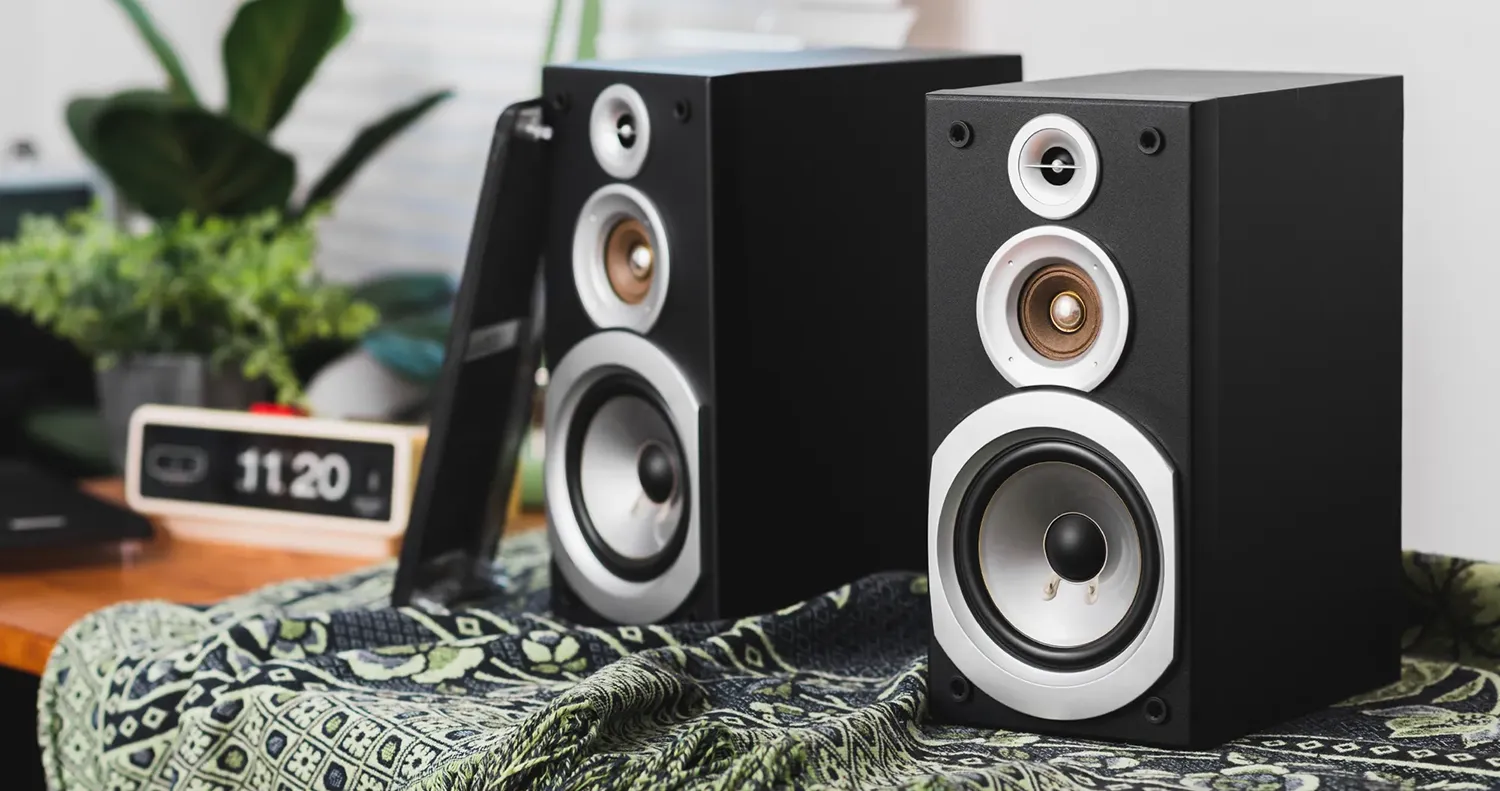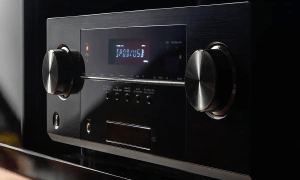Short answer, yes, when matched to the room and supported by smart setup. Great audio doesn’t require giant towers. A well designed pair of bookshelf speakers can deliver clean vocals, precise imaging, and enough punch for most living rooms. Music plays with focus and texture, while movie dialog stays clear at normal volume. Add a properly chosen sub and the system gains real weight without taking over the room. Placement is flexible, stands or a sturdy console both work when you give the cabinets some breathing space. With smart setup and a sensible budget, bookshelves become a balanced choice that fits daily life and still feels special on movie night.
RELATED: Bookshelf Speakers vs. Floorstanders
What a bookshelf speaker really is

Think compact box with a tweeter for the top end and a mid bass driver for the body of the sound. Most models are passive, so you power them with an amplifier or an AV receiver. The name is a bit of a mislead. They do not need to sit on a shelf. Many owners place them on stands so the tweeter sits at ear height. A sturdy media console can work too, as long as you give the cabinet some air around the back and sides.
Why the format suits real rooms
Small cabinets are easier to place. You can aim them at the couch, keep walkways clear, and avoid blocking windows. Imaging is often excellent because the drivers sit closer together, so voices and instruments lock into a stable center. In apartments and townhouses, a compact pair reaches satisfying levels without shaking the building. Add a well chosen sub later and you keep the footprint small while filling in the lowest octave.
Music performance, what to expect
Good bookshelf speakers present vocals with focus and texture. Acoustic instruments carry natural tone. With careful placement, you get a clean phantom center where the singer seems to stand between the cabinets. Deep bass is not their main job, and that is fine. Many models reach into the forties in hertz with control, which covers bass guitar fundamentals and most kick drums. A sub extends the system into the twenties for pipe organ and electronic lows, but music still sounds complete without it in small rooms.
Movie performance, where they surprise
Modern soundtracks rely on clear dialog and precise effects. A compact left and right pair, plus a matching center, delivers strong intelligibility at sane volumes. Surround speakers of the same family complete the wraparound bubble. For impact during storms and rocket launches, add a subwoofer. That handoff is by design. Let the sub handle the heavy lifting while the bookshelves keep the midrange clean and the highs crisp. The result feels larger than it looks.
When towers still make sense
Large rooms, long viewing distances, and a taste for high playback levels can push compact speakers beyond their comfort zone. Tall cabinets move more air, often dig deeper, and offer more headroom for big scenes. If you sit 12 to 15 ft. from the screen in an open plan room, towers with a sub can be the simple way to reach reference levels. For everyone else, a well placed bookshelf pair with a sub often equals or beats a random tower purchase.
How to set them up for both music and movies

Start with stands or shelf placement that puts the tweeter at ear height when seated. Space the speakers about as far apart as your main listening distance, then toe them in slightly until the center image snaps into focus. Keep some space behind the cabinets. 8″ to 24″ from the wall works for many designs. In your AV receiver, set the speakers to small and begin with an 80 hertz crossover. That setting sends deep bass to the sub where it belongs, cleans the midrange, and protects the main drivers when you turn things up.
Your room changes the sound more than you think. Bare walls reflect highs, corners amplify lows, and furniture can swallow certain notes. Most AV receivers include a calibration mic and software that measures your speakers, then applies filters to even out the response. Run the routine, save the profile, then live with it for a few days before making tiny level tweaks. This step often delivers a bigger improvement than chasing one more watt on a spec sheet.
Model ideas for music first listening
- KEF LS50 Meta, precise imaging and a point source feel from the coaxial driver.
- Q Acoustics 3030i, warm tone, relaxed top end, and a forgiving cabinet that keeps resonance down.
- Wharfedale Diamond 12.2, smooth mids for long sessions without ear fatigue.
- Polk Reserve R200, lively dynamics that make rock and pop jump without turning sharp.
- Bowers and Wilkins 606 S3, detailed highs with a clean midrange that flatters vocals.
- SVS Prime Bookshelf, balanced tuning and strong value, easy to match with a sub.
Model ideas for movie leaning rooms
- Klipsch RP 600M II, efficient and energetic, pairs well with modest receiver power.
- ELAC Debut 2 B6.2, honest tuning, good bass reach for the size, and friendly pricing.
- KEF Q350, even dispersion that helps off axis seats in a wider living room.
- Polk Signature Elite ES20, clear dialog when used as mains with a matched center.
- Monitor Audio Bronze 100, crisp detail with solid presence for effects and scores.
Centers and subs that match well
If you watch a lot of films, invest in a proper center from the same series as your mains. Dialog will track the screen naturally and voices will keep the same tone as they move across channels. For the low end, a compact sealed sub such as RSL Speedwoofer 10S MKII or SVS SB 1000 Pro integrates easily in smaller rooms. Ported designs like SVS PB 1000 Pro or HSU VTF 2 MK5 deliver more weight in larger spaces. Set the crossover around 80 hertz to start, then adjust by ear after calibration.
Amplifiers and receivers that make life easy
A competent AV receiver keeps switching simple and adds room correction. Denon AVR S970H is a friendly starter with eARC for television apps and a clear setup flow. Yamaha RX V6A brings MusicCast streaming and intuitive menus. Onkyo TX RZ50 steps up with Dirac Live calibration that can tame tricky rooms and open plans. Music only listeners who prefer two channel gear can look at compact integrated amps with a sub out, then add a simple room correction device if needed.
Placement tips
Bookshelves on furniture can leave little space behind the port, which can cause boom. Pull the cabinet forward so the front edge sits flush with the shelf. Stands should be sturdy and filled if possible. Wobbly supports blur imaging. Toe in until the center image is strong, then stop. Too much angle can narrow the stage. If the treble feels bright, aim the speakers a touch wider. Small moves make big differences, so change one thing at a time and listen.
How to balance music and movie priorities
If you stream concerts and spin vinyl, aim for speakers with smooth mids and clean treble. Pair them with a sealed sub for tighter bass lines. If you spend more time with action and sci fi, pick speakers with good dynamics and add a ported sub that holds output into the low twenties. Keep the crossover in the eighty range either way. That keeps the blend seamless when you switch from jazz to a chase scene.
Common mistakes to avoid
Do not shove a rear ported cabinet against a wall. Give it room to breathe.
Do not skip the calibration mic routine in your receiver. Free performance is free performance.
Do not bury a center channel inside a console. Pull it forward so the front baffle is flush with the shelf.
Do not chase giant peak watt numbers. Stable power and proper setup beat flashy claims.
Do not forget stands. Ear height matters more than another ten watts.
A quick plan for first time buyers
Choose a bookshelf model that fits your budget and your room size. Add a matching center if you watch a lot of movies. Pick a sub that suits the space, sealed for small rooms, ported for larger rooms. Place the speakers with care, run calibration, then fine tune with small changes. Save for a second sub later if you have a long couch or multiple seats. Consistency across the row matters more than a single loud peak at one position.
Final word
Bookshelf speakers are a smart choice for music and movies when you match them to the room and support them with a subwoofer and careful setup. They offer high value, strong imaging, and flexible placement. Towers still have their place, especially in large rooms, yet many listeners will get better results with compact speakers, a good center, and a capable sub. Start with the room you have, use the tools you own, and let your ears be the judge after a week of listening. When voices sound natural and the score swells without strain, you will know you built the right system for your space.



























